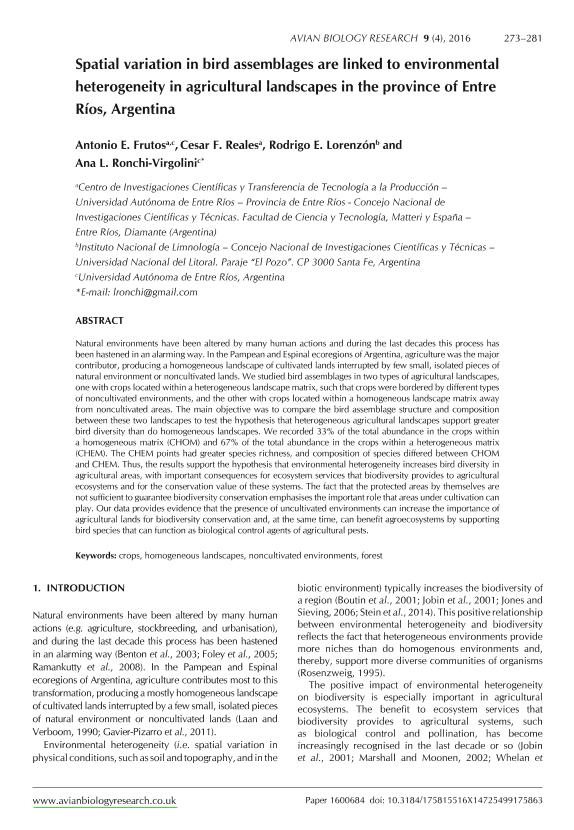Artículo
Spatial variation in bird assemblages are linked to environmental heterogeneity in agricultural landscapes in the province of Entre Ríos, Argentina
Frutos, Antonio Esteban ; Reales, César Fabricio
; Reales, César Fabricio ; Lorenzón, Rodrigo Ezequiel
; Lorenzón, Rodrigo Ezequiel ; Ronchi Virgolini, Ana Laura
; Ronchi Virgolini, Ana Laura
 ; Reales, César Fabricio
; Reales, César Fabricio ; Lorenzón, Rodrigo Ezequiel
; Lorenzón, Rodrigo Ezequiel ; Ronchi Virgolini, Ana Laura
; Ronchi Virgolini, Ana Laura
Fecha de publicación:
11/2016
Editorial:
Science Reviews 2000 Ltd
Revista:
Avian Biology Research
ISSN:
1758-1559
Idioma:
Inglés
Tipo de recurso:
Artículo publicado
Clasificación temática:
Resumen
Natural environments have been altered by many human actions and during the last decades this process has been hastened in an alarming way. In the Pampean and Espinal ecoregions of Argentina, agriculture was the major contributor, producing a homogeneous landscape of cultivated lands interrupted by few small, isolated pieces of natural environment or noncultivated lands. We studied bird assemblages in two types of agricultural landscapes, one with crops located within a heterogeneous landscape matrix, such that crops were bordered by different types of noncultivated environments, and the other with crops located within a homogeneous landscape matrix away from noncultivated areas. The main objective was to compare the bird assemblage structure and composition between these two landscapes to test the hypothesis that heterogeneous agricultural landscapes support greater bird diversity than do homogeneous landscapes. We recorded 33% of the total abundance in the crops within a homogeneous matrix (CHOM) and 67% of the total abundance in the crops within a heterogeneous matrix (CHEM). The CHEM points had greater species richness, and composition of species differed between CHOM and CHEM. Thus, the results support the hypothesis that environmental heterogeneity increases bird diversity in agricultural areas, with important consequences for ecosystem services that biodiversity provides to agricultural ecosystems and for the conservation value of these systems. The fact that the protected areas by themselves are not sufficient to guarantee biodiversity conservation emphasises the important role that areas under cultivation can play. Our data provides evidence that the presence of uncultivated environments can increase the importance of agricultural lands for biodiversity conservation and, at the same time, can benefit agroecosystems by supporting bird species that can function as biological control agents of agricultural pests.
Palabras clave:
Crops
,
Homogeneous Landscapes
,
Noncultivated Environments
,
Forest
Archivos asociados
Licencia
Identificadores
Colecciones
Articulos(CICYTTP)
Articulos de CENTRO DE INV.CIENT.Y TRANSFERENCIA TEC A LA PROD
Articulos de CENTRO DE INV.CIENT.Y TRANSFERENCIA TEC A LA PROD
Articulos(INALI)
Articulos de INST.NAC.DE LIMNOLOGIA (I)
Articulos de INST.NAC.DE LIMNOLOGIA (I)
Citación
Frutos, Antonio Esteban; Reales, César Fabricio; Lorenzón, Rodrigo Ezequiel; Ronchi Virgolini, Ana Laura; Spatial variation in bird assemblages are linked to environmental heterogeneity in agricultural landscapes in the province of Entre Ríos, Argentina; Science Reviews 2000 Ltd; Avian Biology Research; 9; 4; 11-2016; 273-281
Compartir
Altmétricas



